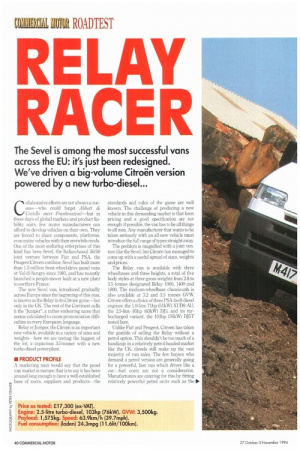R ELAY R A CE R C ollalmative efforts are not always a success—who could
Page 42

If you've noticed an error in this article please click here to report it so we can fix it.
forget Abbott & Costello meet Frankenstein?—but in these days of global markets and product liability suits, few motor manufacturers can afford to develop vehicles on their own. They are forced to share components, platforms, even entire vehicles with their erstwhile rivals. One of the most enduring enterprises of this kind has been Sevel, the Italian-based 50/50 joint venture between Fiat and PSA, the Peugeot/Citroen combine. Sevel has built more than 1.3 million front-wheel-drive panel vans at Val-di-Sangro since 1981, and has recently launched a people-mover built at a new plant in northern France.
The new Sevel van, introduced gradually aaoss Europe since the beginning of this year, is known as the Relay in its Citroen guise—but only in the UK. The rest of the Continent calls it the "Jumper", a rather endearing name that seems calculated to cause pronunciation difficulties in every European language.
Relay orJumper, the Citroen is an important new vehicle, available in a variety of sizes and weights—here we are testing the biggest of the lot, a capacious 3.5-tonner with a new turbo-diesel powerplant A marketing man would say that the panel van market is mature; that is to say it has been around long enough to have a well-established „ base of users, suppliers and products—the standards and rules of the game are well known. The challenge of producing a new vehicle in this demanding market is that keen pricing and a good specification are not enough: if possible, the van has to be all things to all men. Any manufacturer that wants to be taken seriously with an all-new vehicle must introduce the full range of types straight away.
The problem is magnified with a joint venture like the Sevel. but Citroen has managed to come up with a useful spread of sizes, weights and prices.
The Relay van is available with three wheelbases and three heights, a total of five body styles at three gross weights from 2.8 to 3.5 tonnes designated Relay 1000, 14(X) and 1800. The medium-wheelbase chassis-cab is also available at 3.2 and 3.5 tonnes GVW Citroen offers a choice of three PSA-built diesel engines: the 1.9-litre 71hp (51kW) XUD9 AU; the 2.5-litre 85hp (63kW) DJ5; and its turbocharged variant, the 103hp (76kW) DJ5T tested here.
Unlike Fiat and Peugeot, Citroen has taken the gamble of selling the Relay without a petrol option. This shouldn't be too much of a handicap: in a relatively petrol-headed market like the UK, diesels still make up the vast majority of van sales. The few buyers who demand a petrol version are generally going for a powerful, fast van which drives like a car—fuel costs are not a consideration. Manufacturers are catering for this by fitting relatively powerful petrol units such as the








































































































